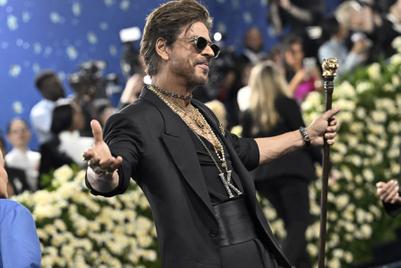Very few of us millennials actually know or realise that the Constitution of India is actually an illustrated history of India. With Republic Day just around the corner, I thought, it would be nice to focus on the wondrous document that the constitution is – a book that not only is the path definer for the nation, but also a visual chronicler of our mythology, history, geography and culture.
- They say you can judge a book from its cover. The intricate gold pattern on the front and back cover of the Constitution of India is borrowed from the famous Ajanta murals.
- The first part of the constitution starts with a popular Indus Valley seal-mark, the bull. The rarity of this zebu motif seal is intriguing. The zebu-bull may symbolise the leader of the herd, whose strength and virility protects the herd and ensures the procreation of the species. When carved in stone, the zebu bull represents the most powerful clan or top officials. And with that seal of authority does the constitution start.
- Part II of the constitution deals with citizenship. This part is visually represented by India’s Vedic Age in the book. The Vedic Age was a time when the worship of personified powers (Agni, Indra, Surya, etc.) was common practice and there was hardly any artistic rendition of these. Most sacred rituals and practices were only known to Brahmans and handed down orally to pupils. Well, the constitution shows that era through a Gurukul or Hermitage school.
- The part on Fundamental Rights (Part III) has been depicted by an illustration of Rama, Lakshman, Sita and the Part 4 on Directives of State Policy begins with the iconic scene of Arjun and Krishna’s conversation before the war.
- Part V of the constitution deals with the union, the executive, the president and the vice president. The image of Buddha’s Enlightenment is lent to the part on rules related to the president and vice president. This was a time where the term ‘enlightenment’ could also be understood as the awakening of the human race from innocence to consciousness. Very subtle, but emphatic. By the 8th century, spiritual and philosophical speculation had advanced much further, and were more Kshatriya in their origin than Brahmin. So this was a period of huge change in society. Mahavira consequently dominates the pages after in Part VI.
- The Gupta period was the Golden Age of India – the combination of brilliant intellectual and spiritual development, also characterised by great art and literature. The paintings of Ajanta, the texts of Kalidasa, the mathematical genius of Aryabhatta – were all part of the Gupta period. At that time, India was contributing to 25% of the World GDP, and held on to the number one position as an economic super power for well over 1,000 years. The Gupta rule manifests itself in an artwork representing the Nalanda University (established at that time) where the intermingling of cultures was common.
- Ancient to Early Medieval art is depicted through a rendering of Arjuna’s Penance (from Mahabalipuram) – Part XIII and a Nataraja Chola Bronze – Part XII on different pages. Wonderful symbology and an unparalleled process of creation. The Chola Bronze Nataraja was in fact created as per the instructions of the Shilp Shastras (Craft Manual).
- Part XIV has a scene from Akbar’s court depicting Mughal rule (known for pioneering art and architecture) which eventually leads in Part XV into the the Maratha and Sikh renders of Shivaji and Guru Gobind Singh.
- Part XVII kicks off the depiction of The Freedom Struggle depicted by a series of freedom fighters starting with Rani Lakshmibai and Tipu Sultan to Gandhi’s Dandi March and also takes into account his tour of Noakhali as the great peacemaker. Subhash Chandra Bose also has an artwork dedicated to him in the constitution – in fact the nation celebrated his 125th anniversary a few days ago.
- For Parts XX to XXII scenes from the Himalayas, the desert and the ocean have been used in the magnum opus.
- The calligraphy was done on pages that were given to be framed in the hashi’a (borders) in the traditional way, as used to be the case with Mughal and Sultanate manuscripts. There are two types of borders that have been used throughout the manuscript. While all pages have a simple, gold-speckled border, some at the opening of a Schedule, and the page where every schedule ends, have a second, inner border of gold ornament.
The calligraphy in the book was done by Prem Behari Narain Raizada, using a holder and nib (No. 303 nib). It was illuminated by Nandalal Bose, known as the artist laureate of India, and his students, from Kala Bhavan (Institute of Fine Arts), Visvabharati University, including Beohar Rammanohar Sinha (credited, among other items, for the Preamble page), Dinanath Bhargava (credited for the emblem of India), Kripal Singh Shekhawat, A. Perumal, Vinayak Sivram Masoji and other artists, which included Bose's three children: Biswarup Bose (and his wife Nibedita), Gauri Bhanja (and her daughter, Bani Patel) and Jamuna Sen. Amala Bose, later wife of ABP Group chairman Kanailal Sarkar, Jagdish Mittal , Rajniti Singh and Dhirendra Krishna Deb Barman were also in the team of illustrators. The illustrations were done in indigenous methods, using gold-leaf and stone colors. The name of the calligrapher is signed as Prem at bottom left of the text window on each page; the name of the illustrator is signed at bottom left of each illustrated page frame. Pictures are separately signed. The manuscript was written on microbe-resistant parchment sheets measuring 45.7 cm × 58.4 cm with a shelf life of a thousand years. The finished manuscript consisted of 234 pages and weighed ~13 kg. This manuscript was signed by the members of the Constituent Assembly on 24th January 1950. The glass cases for preservation of the English and Hindi manuscripts in the Parliament library were developed jointly by National Physical Laboratory, New Delhi and Getty Conservation Institute, USA, and installed in March 1994.
The Constitution of India has a simply wonderful visual story to tell. The journey of its creation is nothing short of a bestseller laden with adequate passion, struggle and its own share of conflicts. True, it is often stated to be a bag of borrowings, taking governance guidelines from different nations; but what it does not borrow from anyone in the world is its rich artistic heritage.
What can modern art directors learn from an epic compilation like the constitution?
1. A sense of history. Most of the work we do in advertising is about the future – future plans, future technologies, future ready – but mooring a narrative in history actually gives it gravitas and character.
2. A depiction of philosophy. Often clients ask for vision statements to be written and mission statements to be framed. The constitution does that too with a canvas that covers Buddha to Mahavira to Nalanda.
3. The narration of chronological events. The movement from the Mughals to the Sikhs and Marathas appears in subsequent parts of the constitution without giving the chronological impression on how each of them played their part in getting the British to India – subtly done, without any allusions to time lines.
4. The calligraphy as beautification. Every page in the constitution has a visual character. Distinct, yet interwoven. The borders look as if each page is a ‘firmaan’. Giving the book both character, and authority.
If you have the time, and the inclination, get yourself an illustrated copy of the Constitution. For all of us young Indians, it a great book to browse and imbibe.
(The author is director at Everest.)





.jpg&h=334&w=500&q=100&v=20250320&c=1)
.jpg&h=334&w=500&q=100&v=20250320&c=1)


.jpg&h=334&w=500&q=100&v=20250320&c=1)
.jpg&h=334&w=500&q=100&v=20250320&c=1)

.jpg&h=334&w=500&q=100&v=20250320&c=1)
.jpg&h=334&w=500&q=100&v=20250320&c=1)






.jpg&h=268&w=401&q=100&v=20250320&c=1)

